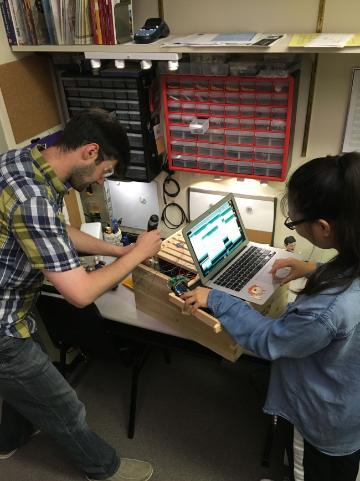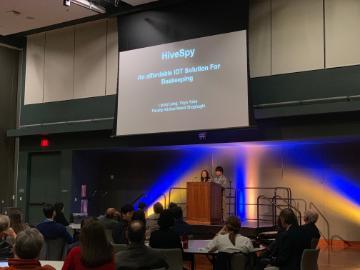About
HiveSpy is working towards automation of beekeeping with a specific focus on labour shortage and the prevention of hive swarming. To learn more about how and why we are doing this, keep reading!
Due to the high demand yet shortage of labor for agriculture much research in the automation of agriculture via so called “smart technologies” has been conducted. One area of agriculture that can be positively impacted is harvesting. An emerging idea is the usage of an interconnected network of sensors or so called an internet of things for providing raw data about the state of the crops in the field. By applying data analysis and analytics techniques such as machine learning and artificial intelligence, humans can not only make sense of the data, but can also make predictions regarding the state of the plants and the environment in the field. One sector of agriculture that is of interest to us is beekeeping and honey production. How can we save a beekeeper's time, energy, and money while producing honey?


Left: Prof. Navid Shaghaghi and Liying Liang working on assembling sensors in a hive box. Right: Liying Liyang and Yuya Yabe presenting at IEEE EPICS.
Taking care of bee colonies, however, has never been an easy task. For instance, swarming, is the process in which a new honey bee colony is formed by splitting the original colony into two when the colony runs out of production space in its hive. The queen lays a special queen egg and leaves with 60% of the workers to find a suitable location for building a new hive. Meanwhile the new larva, immature worker bees, and the new virgin queen will consume the stored honey without collecting new pollen. Hence, the beekeeper has not only lost the entire crop for that cycle, she has also lost her workforce.
To prevent the hives from swarming, beekeepers need to keep a constant check on the production yield and harvest the honey in a timely fashion. As the apiary scales up, beekeepers run out of manpower to check each frame. Our project is thus the design and implementation of an IoT solutions to monitor the production yield effectively. Our solution is more precise, cheaper, and simpler than existing hive monitoring systems on the market as we collect individualized frame weight data rather than whole hive weight data and construct a harvest schedule/plan for the beekeeper that reduces the amount of manual labor necessary to maintain the hives. The task of monitoring every single frame in a hive has not been attempted in industry due to its difficulty, cost, and resource (Communication Bandwidth, computation power, and energy usage) heavy nature.
Research Team
Graduate students:
- Jesse Mayer
- Peter Ferguson
- Sami Lama
- Tatiane Antonio
Undergraduate Students:
- Liying Liang
Past Students:
- Yuya Yabe
- 2nd place award in Forbes AgTech's 2018 ThriveX challenge
- The Thrive-X challenge focused on automation for addressing labor shortage in agriculture
- 2019 EAI GoodTechs: HiveSpy
- 2019 IEEE GHTC: Identifying Beehive Frames Ready For Harvesting
- EPICS in IEEE Expo, February 2019
- Showcased the work-in-progress project at EPICS, Engineering Projects in Community Service
- EAI GoodTechs September 2019
- Paper published in ACM: HiveSpy
- Presented Poster
- IEEE Global Humanitarian Technology Conference (GHTC) October 2019
- Paper published in IEEE: Link coming soon
- Presented Poster - See Abstract
- Presented Paper - Slides coming soon.
